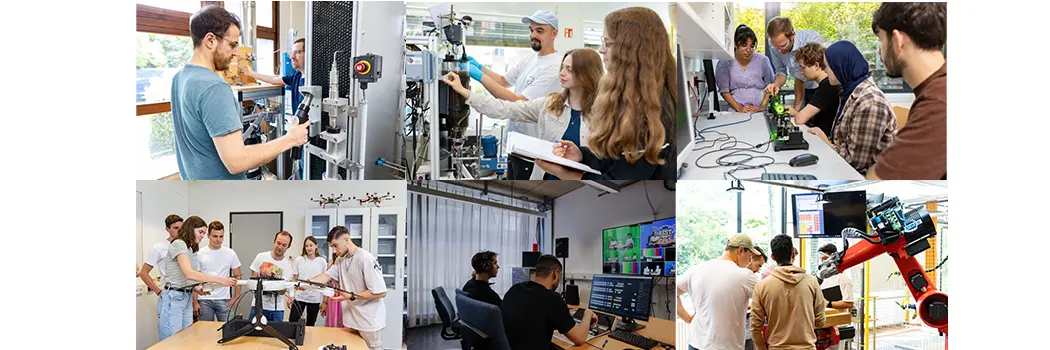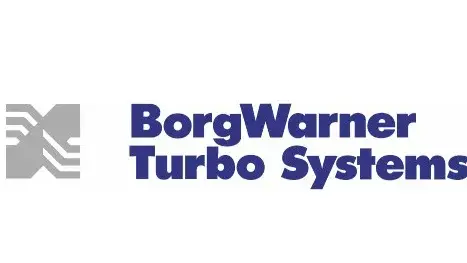
Fachgebiete am Fachbereich Ingenieurwissenschaften im Überblick
Energy conversion and thermal drive machines
In the field of "Energy Conversion and Thermal Drive Machines", experimental methods and numerical simulations are used to work on research topics, in particular on the thermodynamic function of flow compressors. One specialization of the investigations is the behavior of flow compressors at the pumping limit, i.e. near unstable operation.
The experimental measurements are carried out on flow compressors of exhaust gas turbochargers. For this purpose, the exhaust gas turbochargers are operated on internal combustion engines. The measurements are carried out in particular by means of temperature and pressure measurements. Pressure transmitters with an M5x0.5 thread and a dynamic range of up to 50 kHz are used for the pressure measurements.
Various control units (ECU) (Bosch-ETK, Schaeffler Protronic and Trijekt Premium) and application interfaces (ETAS INVA, Schaeffler MARC, Trijekt) are available for the application of the combustion engines.
The flow simulations are carried out with Ansys CFX. The CFturbo program is available for the design of flow compressors.
Research projects
RedNOx project
Funded by: BMWK (ZIM cooperation project), funding number KK5345102MP3
Funding period: 01.06.2023 - 30.11.2025
The research project addresses the development of an easily retrofittable, cost-effective and space-saving emission reduction system for nitrogen oxides, which is intended for the energetic utilization of biogas of various compositions in CHP plants, especially for plants in the 150 - 500 kW power classes with application in agriculture. The main energy source of the biogas used to fire the CHP units addressed in this project is methane (CH4), which accounts for 50-75% by volume. Another important component is the inert gasCO2 with a share of 20-45% by volume. The highproportion of CO2 leads to significant differences in the physico-chemical processes during the combustion of biogas compared to the combustion of pure methane or natural gas. For example, theCO2 content reduces the ignitability of the fuel and the flame speed decreases. It is precisely this aspect of the dependence of the combustion process on the fuel composition that represents a central development focus of the project.
The planned RedNOx system is based on the principle of water injection into the intake tract of the combustion engine. The positive effect of the process on nitrogen oxide emissions is already known from the field of diesel engine development. It has not yet played a role in the economic field of CHP units. However, some current and promising work from application-oriented science on this topic is known. In particular, the process promises great potential to reduce not only nitrogen oxide emissions but also the use of state-of-the-art, cost- and raw material-intensive catalytic systems.
KomRadV project
Funded by: IWB-EFRE program Hessen, funding number 20005852
Funding period: 01.09.2019 - 31.08.2022
The research project "Expansion of expertise in engineering methodology for the design of centrifugal compressors" (KomRadV) deals with the expansion of expertise with regard to the unstable operating range of centrifugal compressors by means of numerical flow simulations (CFD) with the aid of experimental investigations. This operating range is characterized by the compressor pumping limit, which impairs the flow through the compressor at low volume flow and high pressure ratio. The goal of the research project is to create expertise in the field of pumping limit determination and to make statements about the pumping tendency of compressor stages.
High-resolution, transient simulations are used to identify fluid mechanical phenomena that cause unstable flow behavior and can therefore be responsible for compressor pumping. Currently, the numerical investigation of such phenomena is exclusively associated with extremely complex, time-consuming and costly simulations. For this reason, it makes sense to research a suitable methodology for the design/optimization of compressor wheels using a reduced model, as this considerably reduces the computational effort. In the course of all investigations, whether at the experimental or numerical level, knowledge is not only gained with regard to the determination of pumping limits, but also expertise in many areas of compressor development.
The project is being carried out in cooperation with the GLR field at TU Darmstadt and BorgWarner Turbosystems Engineering GmbH.



DiagV project
DiagV (Diagonal compressor for small-cylinder internal combustion engines)
BMBF FHProfUnt 13FH050PX4, 01.02.2015 - 31.07.2018
The research project investigates the possibility of influencing the compressor pumping limit by changing the design of the compressor wheel geometry. The compressor pumping limit impairs the flow through the compressor at low flow rates and high pressure ratios. The goal is to shift the pumping limit to lower flow rates or higher pressure ratios.
pressure ratios. In the research project, various compressor wheel geometries were designed and numerically analyzed with the aid of flow simulations (CFD). A compressor wheel geometry was selected from the results, produced as a prototype and measured experimentally on the compressor test bench at TU Darmstadt. The experimental results showed
the potential of the diagonal compressor wheel compared to the conventional radial compressor wheel to change the pumping limit in the desired direction. The numerical simulations showed indications of the causes of compressor pumping, which lie in a flow instability in the blade boundary layer. An engine is currently being modified so that the experimental investigations can be continued there. The numerical simulations to investigate the compressor pumping limit are to be continued in a research project that is currently in preparation.